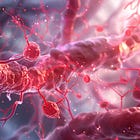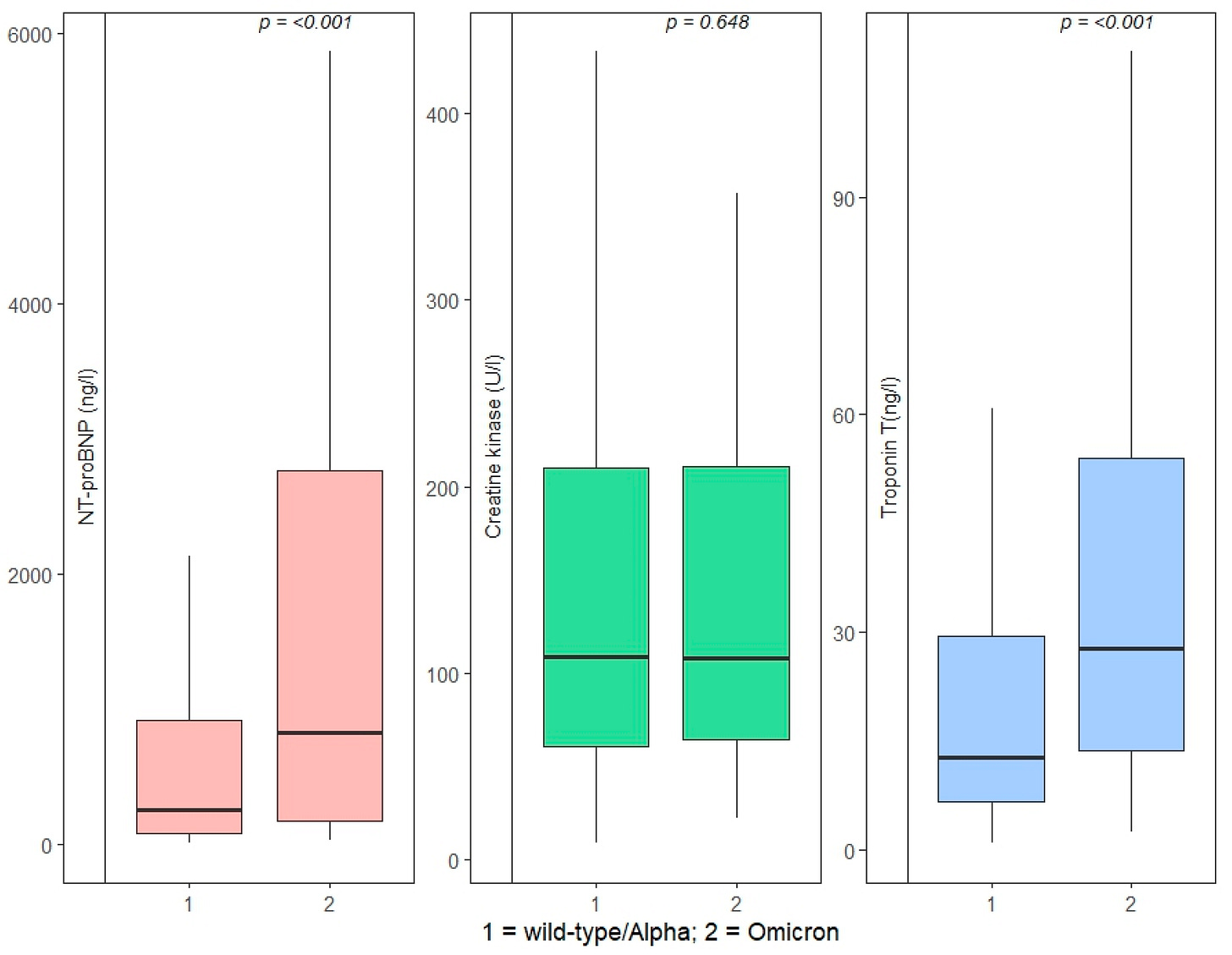Cardiac Damage from Omicron infection
And beef is not bad for your heart
Today’s article will be a quicker one, directly correlated with the next article covering the long-term consequences of a SARS-CoV-2 infection. In late October, during what called a linguistic convergence (when specific words, and terms independently arise in certain fields within a short time, proving a good quality signal) I covered a paper about the presence of microvascular endothelial dysfunction present in a large portion of Long Covid patients.
These were measured after “mild” infection, meaning no hospitalization. Explanation of the main marker used.
NT-proBNP is commonly used as a marker for heart stress, failure, and other major cardiac events. Higher NT-proBNP means the heart is working harder than normal, and the cause could be higher blood pressure, damage to the heart itself, or… endothelial dysfunction.
Cardiac Damage in Patients Infected with Different SARS-CoV-2 Variants of Concern
One of, if not the most stupid argument after the botched understanding of misfolded protein, especially prions and amyloid formation has been “Omicron is just the flu”, by a large portion of “influencers”. After 6 months of Omicron surfacing I have argued it wasn’t “mild”, it just didn’t kill people fast enough, especially via pneumonia.
We conducted a single-center retrospective cohort analysis comparing biomarkers and clinical outcomes in hospitalized patients infected with the wild-type or Alpha (wt/Alpha) VOC against patients infected with the Omicron VOC. We included 428 patients infected with the wt/Alpha VOC and 117 patients infected with the Omicron VOC. The Omicron cohort had higher maximal median high-sensitivity Troponin-T (hs-TnT) levels (wt/Alpha: 12.8 ng/L, IQR 6.6–29.5 vs. Omicron: 27.8 ng/L, IQR 13.7–54.0; p < 0.001) and N-terminal prohormone of brain natriuretic peptide (NT-proBNP) (wt/Alpha: 256 ng/L, IQR 74.5–913.5 vs. Omicron: 825 ng/L, IQR 168–2759; p < 0.001) levels. This remained true for patients under 65 years of age and without pre-existing cardiovascular disease (hs-TnT (wt/Alpha: 6.1 ng/L, IQR 2.5–10.25 vs. Omicron: 8.6 ng/L, IQR 6.2–15.7; p = 0.007) and NT-proBNP (wt/Alpha: 63 ng/L, IQR 25–223.75 vs. Omicron: 158 ng/L, IQR 75.5–299.5; p = 0.006)). In-hospital mortality was similar between the two groups (wt/Alpha: 53 or 12.7% vs. Omicron: 9 or 7.7%; p = 0.132) and more patients infected with wt/Alpha VOC required intensive care admission (wt/Alpha: 93 or 22.2% vs. Omicron: 14 or 12%; p = 0.014). Increased cardiac biomarkers were correlated with a higher risk of mortality and ICU admission in both groups. Herein, we detected higher levels of cardiac biomarkers in hospitalized patients infected with the Omicron VOC when compared to wt/Alpha, being indicative of higher cardiac involvement. Although hs-TnT and NT-proBNP levels were higher in the Omicron cohort and both markers were linked to in hospital mortality in both groups, the mortality rates were similar.
While the authors used hospitalization data, at least to me, this can easily be extrapolated to larger populations as we will cover in the next article. Here they discovered that Omicron has a significantly higher cardiac injury and stress compared to even Alpha, which indicates that an Omicron infection has a significant cardiovascular burden.
Even in patients without pre-existing cardiovascular disease, the markers remained high. They argue that Omicron has a higher tropism (preference to infect specific places) for the heart, independent of inflammation. Given that NT-proBNP is also a reliable and useful marker for microvascular dysfunction, it should be no surprise the authors state “A significant role may also be attributed to microthrombi caused by the hypercoagulable state induced by the infection”.
In the article above, the authors used a rather intricate model to prove that SARS-CoV-2 can persist in cardiac tissue without causing functional impairment, which in their model can’t be measured, but in a human, it would cause NT-proBNP to increase. Omicron is a highly immune evasive variant, with an absurd (almost mathematical-defying) replication rate and viral load, add both and you get persistence in different tissues.
I expect a trend reversal in 5 to 10 years. Alas, this was just a short one because the one about long-term consequences will be quite larger. If you are missing the argument, my argument is that multiple infections per year will contribute to long-term sequelae and the development of diseases. Omicron still has that nasty Superantigenic site, it is just “milder”.
I will try to publish it on Christmas Eve or around it. Or write something else, but most definitely a Christmas Eve email. And since we are talking about heart disease, heart “stuff”.
Beef Consumption and Cardiovascular Disease Risk Factors: A Systematic Review and Meta-analysis of Randomized Controlled Trials
Results
Twenty relevant RCTs that met the criteria were included. Beef intake did not impact blood pressure or most lipoprotein-related variables, including total cholesterol, HDL-cholesterol, triglycerides, non–HDL-cholesterol, apolipoprotein A or B, and VLDL-cholesterol. Beef consumption had a small but significant effect on LDL-cholesterol (0.11; 95% CI: 0.008, 0.20; P = 0.03), corresponding to ∼2.7 mg/dL higher LDL-cholesterol in diets containing more beef than that in low-beef or -o beef comparator diets. Sensitivity analyses show this effect was lost when 1 influential study was removed.
Conclusions
Daily unprocessed beef intake do not significantly affect most blood lipids, apolipoproteins, or blood pressures, except for a small increase in LDL-cholesterol compared with diets with less or no beef. Thus, there may be other factors influencing the association of red meat and beef on CVD risk that deserve further investigation.
A lie that is persistently proven wrong, beef intake contributes to Cardiovascular Disease. Yes, it is not the high carbohydrate diet with industrialized fats, no, it is the food we have been eating for thousands of years.
After eggs, red meat, allied with a lower carbohydrate diet is among the best, most nutritious foods on the planet.
I am grateful for your continued support, thank you.






Thank you- it still amazes me that anyone thought self producing “spike protein via mRNA was “bad “ but spike protein from infection was acceptable ( and vice versa for) . A few studies are now coming out re infection and carcinomas etc
Back in Nov of 2019 I was quite laid low by something that attacked my blood oxygen and heart. Took only pints of Burdock root tea over months. Survived. My heart is much better, but not the same, now, in terms of stamina. Idiot meter seems to exacerbate. That we rid ourselves of these evils, I pray daily.